
Papilio multicaudata, the two-tailed swallowtail, is a species of the family Papilionidae found in western North America from British Columbia to Central America.
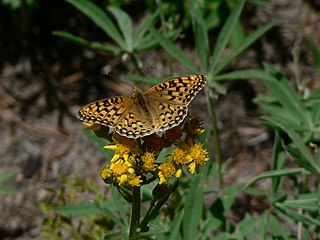
Speyeria zerene, the zerene fritillary, is a butterfly found in the western portions of the United States and Canada. The species was first described by William John Swainson in 1827.

Lycaena phlaeas, the small copper, American copper, or common copper, is a butterfly of the Lycaenids or gossamer-winged butterfly family. According to Guppy and Shepard (2001), its specific name phlaeas is said to be derived either from the Greek φλέγω (phlégo), "to burn up", or from the Latin floreo, "to flourish".

Anthocharis is a Holarctic genus of the butterfly tribe Anthocharini, in the family Pieridae. These are typically small, white-hued butterflies that have colorful marks just inside the tips of the forewings. The tip colors are usually a red-orange hue, hence the name "orange tip". The larvae of these butterfly often consume cruciferous plants containing chemicals called glucosinolates. This genus is characterized by two of the five subcostal veins branching off before the apex of the cell, by the upper radial being only little united with the subcostal, and by the central discocellular being rather long. In all the species the males have at least the apical portion of the forewing orange red or yellow. Only one species inhabits also the northern districts of the Palearctic region, all the others are found in the south of the Palearctic region, also some species occur in North America, but not one species extends into the tropics. The Anthocharis species have only one brood. The butterflies occur in spring.

Glaucopsyche, commonly called blues, is a Holarctic genus of butterfly in the family Lycaenidae, found mainly in Palearctic Asia. For other species called "blues" see subfamily Polyommatinae and genus Plebejus.

The common wood-nymph is a North American species of butterfly in the family Nymphalidae. It is also known as the wood-nymph, grayling, blue-eyed grayling, and the goggle eye.

Asterocampa clyton, the tawny emperor, is a species of brush-footed butterfly. It is native to North America, especially the eastern half from Canada to northern Mexico. The tawny emperor should not be mistaken for a very similar Asterocampa butterfly, the hackberry emperor, which can be distinguished by the white spots near the tip of its forewing and the black eyespot lower along the edge of the forewing.

Glaucopsyche lygdamus, the silvery blue, is a small butterfly native to North America.

Glaucopsyche piasus, the arrowhead blue, is a western North American butterfly of the family Lycaenidae. It is a locally common butterfly that favors prairie, open woodland, and woodland edges and trails.
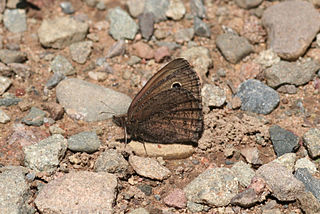
Cercyonis oetus, the small wood-nymph or dark wood-nymph, is a butterfly of the family Nymphalidae. It is found in western North America.

Cercyonis is a genus of butterflies of the subfamily Satyrinae in the family Nymphalidae found in North America. They are commonly called wood-nymphs or wood nymphs.
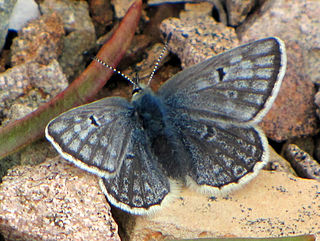
Agriades glandon, the Arctic blue or Glandon blue, is a species of butterfly in the family Lycaenidae. It in found in Eurasia and North America.
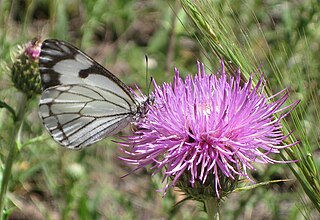
Neophasia menapia, the pine white, is a butterfly in the family Pieridae. It is found in the western United States and in southern British Columbia, Canada.

Ochlodes sylvanoides, the woodland skipper, is a butterfly of the family Hesperiidae. It is found in North America from British Columbia south to southern California, east to Montana, Colorado and Arizona.
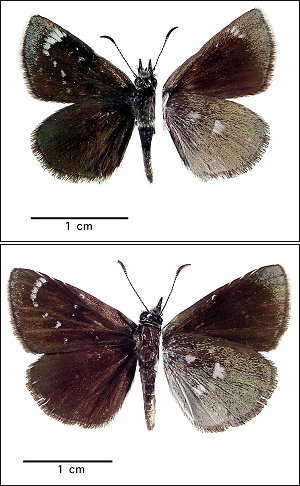
Hesperopsis libya, the Mojave sootywing, Mohave sootywing, Great Basin sootywing or Lena sooty wing, is a butterfly of the family Hesperiidae. It is found in North America from eastern Oregon east to Montana and south to southern California, Arizona, and north-western Mexico including Baja California. Its habitats include alkalai flats, sagebrush desert, desert hills, shale barrens, watercourses, and ravines.
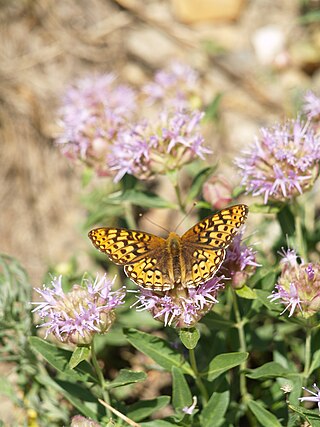
Speyeria egleis, commonly known as the Great Basin fritillary or egleis fritillary, is a butterfly of the family Nymphalidae. It is found in the United States, where it has been recorded from North Dakota southwest through Oregon to California and south to Colorado. The habitat consists of mountain meadows, forest openings and exposed rocky ridges.
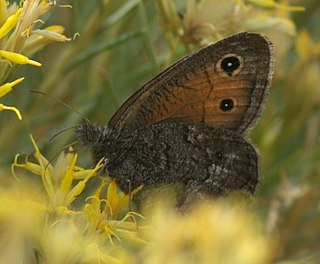
Cercyonis meadii, or Mead's wood nymph, is a species of brush-footed butterfly in the family Nymphalidae. It was first described by William Henry Edwards in 1872 and it is found in North America.

Lycaena xanthoides, the great copper, is a species of copper in the butterfly family Lycaenidae. It is found in North America.



















